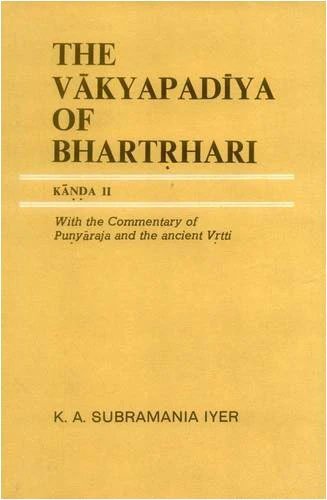Vakyapadiya of Bhartrihari
by K. A. Subramania Iyer | 1965 | 391,768 words
The English translation of the Vakyapadiya by Bhartrihari including commentary extracts and notes. The Vakyapadiya is an ancient Sanskrit text dealing with the philosophy of language. Bhartrhari authored this book in three parts and propounds his theory of Sphotavada (sphota-vada) which understands language as consisting of bursts of sounds conveyi...
This book contains Sanskrit text which you should never take for granted as transcription mistakes are always possible. Always confer with the final source and/or manuscript.
Verse 3.3.8-11
Sanskrit text, Unicode transliteration and English translation of verse 3.3.8-11:
निरात्मकानामुत्पत्तौ नियमः क्वचिदेव यः ।
तेनैवाव्यपवर्गश्च प्राप्त्यभेदे स यत्कृतः ॥ ८ ॥
आत्मान्तरस्य येनात्मा तदात्मेवावधार्यते ।
यतश्चैकस्य नानात्वं तत्त्वं नाध्यवसीयते ॥ ९ ॥
तां शक्तिं समवायाख्यां शक्तीनामुपकारिणीम् ।
भेदाभेदावतिक्रान्तामन्यथैव व्यवस्थिताम् ॥ १० ॥
धर्मं सर्वपदार्थानामतीतः सर्वलक्षणः ।
अनुगृह्णाति संबन्ध इति पूर्वेभ्य आगमः ॥ ११ ॥nirātmakānāmutpattau niyamaḥ kvacideva yaḥ |
tenaivāvyapavargaśca prāptyabhede sa yatkṛtaḥ || 8 ||
ātmāntarasya yenātmā tadātmevāvadhāryate |
yataścaikasya nānātvaṃ tattvaṃ nādhyavasīyate || 9 ||
tāṃ śaktiṃ samavāyākhyāṃ śaktīnāmupakāriṇīm |
bhedābhedāvatikrāntāmanyathaiva vyavasthitām || 10 ||
dharmaṃ sarvapadārthānāmatītaḥ sarvalakṣaṇaḥ |
anugṛhṇāti saṃbandha iti pūrvebhya āgamaḥ || 11 ||8-11. It has been traditionally handed down from the elders that Relation is beyond the characteristics of all things (padārtha), that it is made known by everything (sarvalakṣaṇa) and that it favours that power called inherence (samavāya) by virtue of which the production of things (previously non-existent is restricted to a particular (cause) by which the effect is never separated from such a cause, there being no difference (from conjunction) in the matter of juxtaposition, by which the essence of something is cognised as that of something else, by which neither distinction nor identity of something is perceived, which renders assistance to other powers, which is beyond identity and difference and which is established differently from other things.
Commentary
The difference between relation and inherence is now being pointed out.
[Read verse 8-11 above]
[According to Satkāryavāda, the effect already exists in the cause. Hence, it is the cause which becomes the effect. So particular effects can be found in particular causes only. According to the ‘asatkāryavāda’ also, a particular effect like cloth can exist only in the threads and so on. Thus, the effect is intimately associated with its cause, it is not separated from it even though they are different from each other. This is due to inherence (samavāya) and this is where it. differs from saṃyoga, though the two resemble each other in one respect, namely, that they bring two things together. It is due to inherence that cause and effect, part and whole, the universal and the particular, the quality and substance, though different from each other, appear to be the same. They only appear to be the same, because there is difference between the two in each pair. It is because of this that thinkers hold different views on this matter. Some think that the parts and the whole are the same while others think that they are not. What all this means is that the fact of being found together, of being intimately united (ayutasiddhi) is the limiting factor of inherence. It causes the cognition of a particular substratum (ihapratyaya) between things which are intimately united (ayutasiddha) and not between others. It is Relation which determines this characteristic of inherence. Inherence does not appear to be different from the two things which are united by it, just as the two things themselves do not appear to be different from each other. All of them appear to be mixed up (sammūrchitarūpatvenāvabhāsāt). Inherence is inferred to exist from its effect, namely, the cognition of a particular substratum (ihapratyaya). Inherence is here called a power. As it renders service to things, it cannot be put in the same category as them. As it is a power, one cannot say whether it is identical with that of which it is the power or not. It is not a thing (padārtha), it has to be put in a different category. That is why it is said to be something which is established differently (anyathaiva vyavasthitām). Inherence renders service to the powers called sādhana by making them reside in their substrata. It is such an inherence which is helped by Relation which (1) is not a thing because it lacks that independence which exists in all things, (2) is made known by everything which needs help, and not by fixed things as inherence is, (3) confines inherence to things which are intimately united, (4) gives to inherence the name of relation because of the common characteristic called dependence. Relation which does all these things must necessarily be different from the padārthas. That is why, in this śāstra, it is not merely conjunction and inherence which are relations.]
The author now explains this point further.
